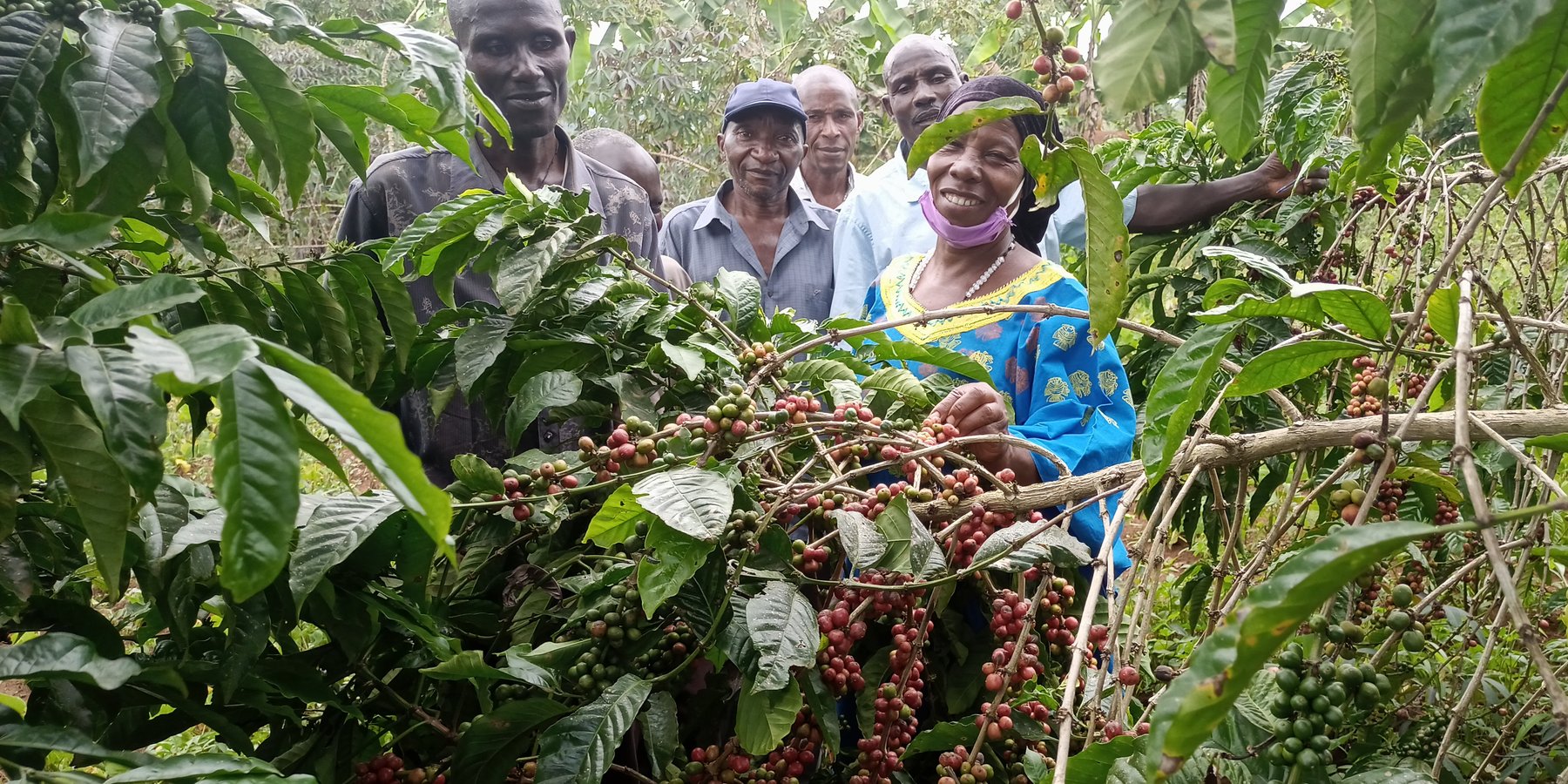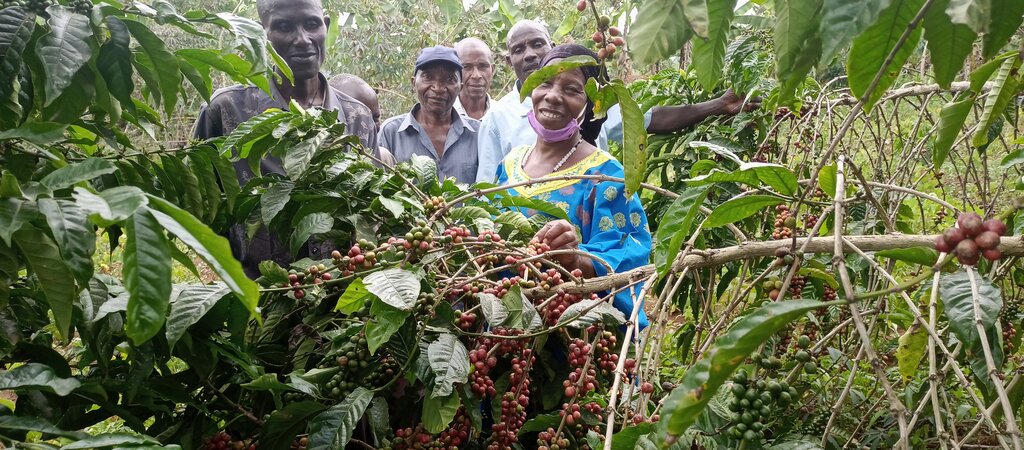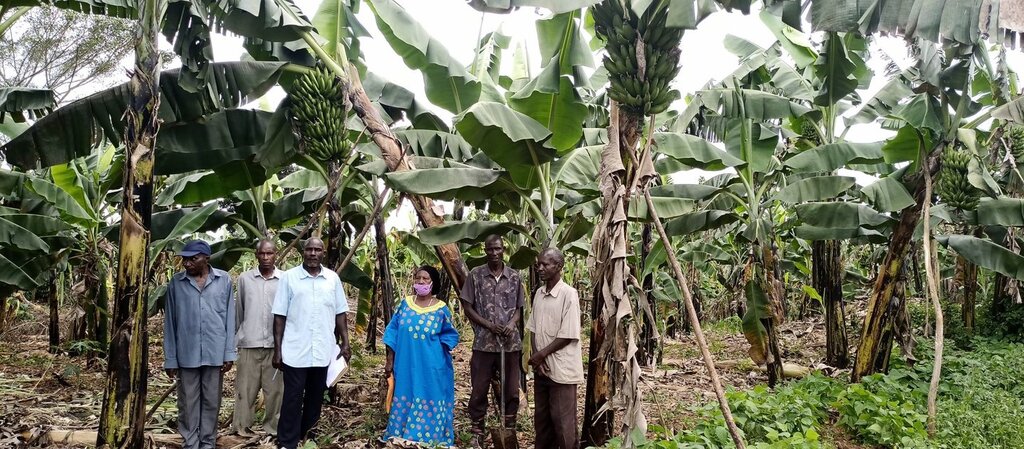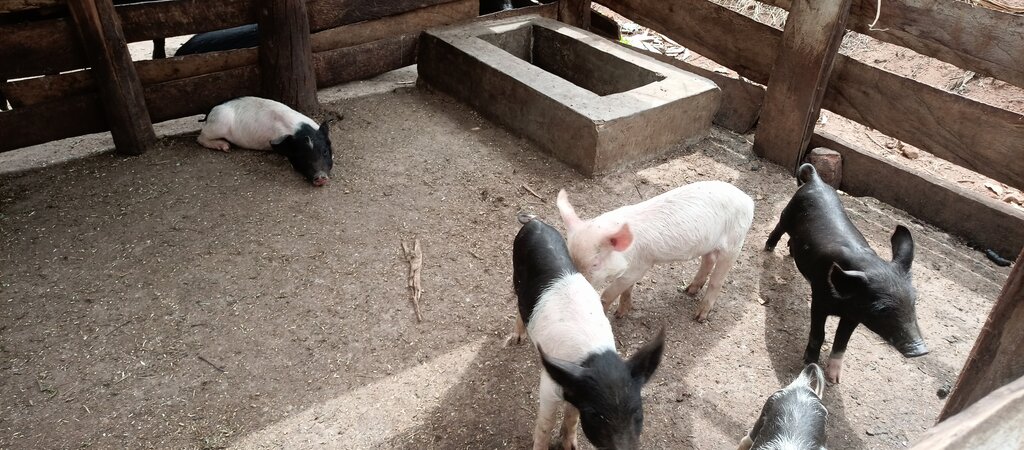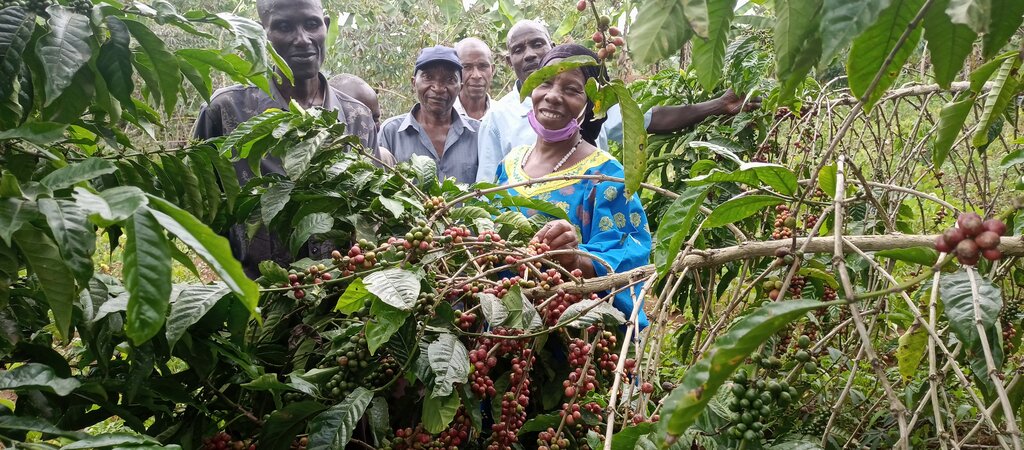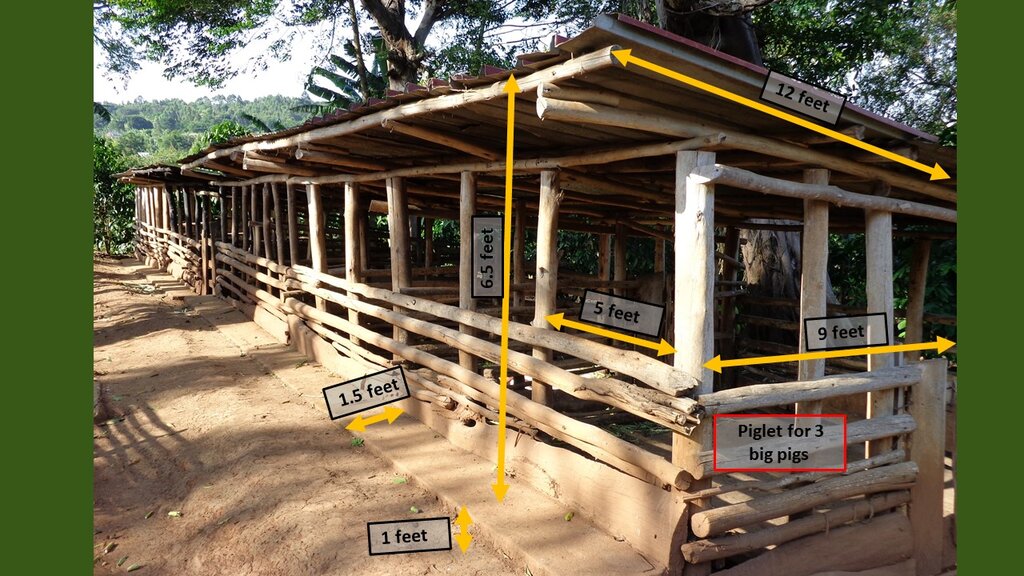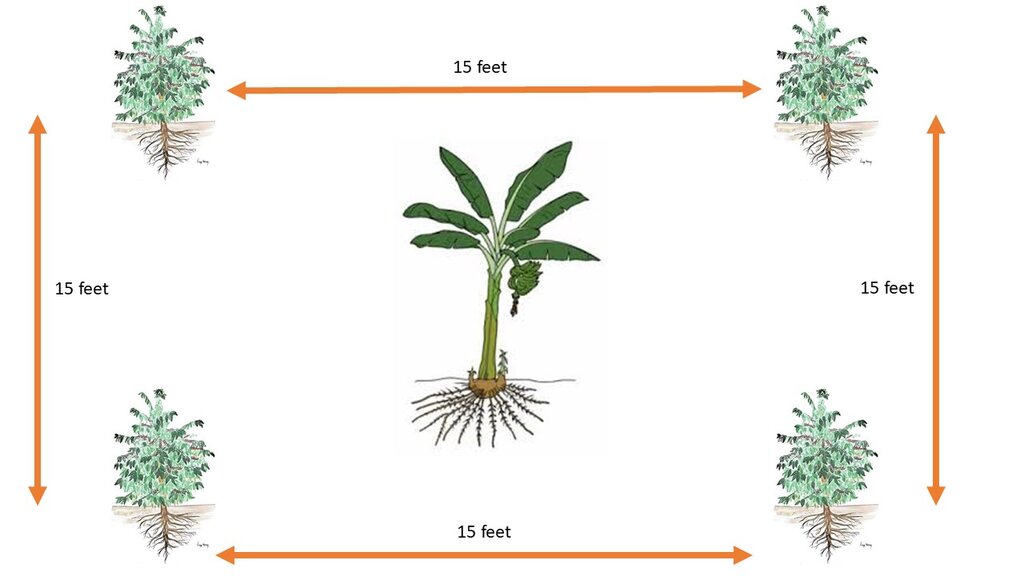Piggery-Banana-Coffee technology [Uganda]
- Creation:
- Update:
- Compiler: Tonny Kyambadde
- Editors: Beatrice Nabukenya, Michael Mulindwa, Kyagaba Prossy, Annika Reimann
- Reviewers: William Critchley, Rima Mekdaschi Studer
Obusa bwe mbizzi kumwanyi ne bitooke
technologies_5914 - Uganda
View sections
Expand all Collapse all1. General information
1.2 Contact details of resource persons and institutions involved in the assessment and documentation of the Technology
co-compiler:
Kyagaba Prossy
Caritas MADDO
Uganda
co-compiler:
co-compiler:
Name of project which facilitated the documentation/ evaluation of the Technology (if relevant)
Euregio-East Africa Livelihood Improvement Programme (EEALIP)Name of the institution(s) which facilitated the documentation/ evaluation of the Technology (if relevant)
Caritas Masaka Diocesan Development Organisation (Caritas MADDO) - Uganda1.3 Conditions regarding the use of data documented through WOCAT
The compiler and key resource person(s) accept the conditions regarding the use of data documented through WOCAT:
Ja
1.4 Declaration on sustainability of the described Technology
Is the Technology described here problematic with regard to land degradation, so that it cannot be declared a sustainable land management technology?
Nee
Comments:
The technology under documentation is practically proven for its efficiency and effectiveness in conserving land and improving productivity.
1.5 Reference to Questionnaire(s) on SLM Approaches (documented using WOCAT)
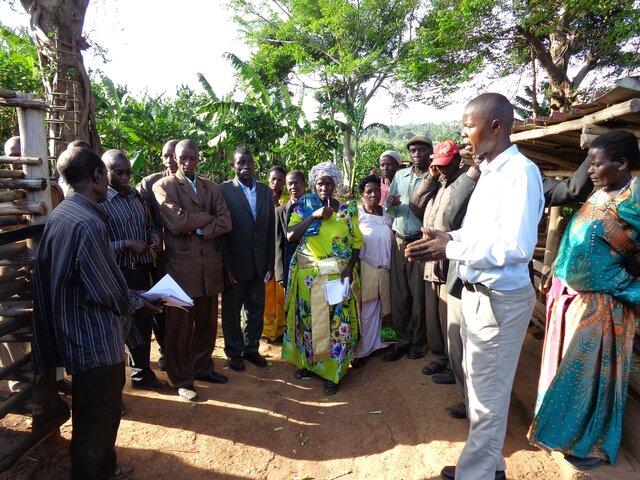
MADDO SLM approach [Uganda]
This integrated soil fertility management approach aims at identifying and promoting practices in land management that can increase soil fertility, reduce land degradation and improve production. Under this specific example, organic manure from a piggery was applied to banana and coffee plantations.
- Compiler: Tonny Kyambadde
2. Description of the SLM Technology
2.1 Short description of the Technology
Definition of the Technology:
The "Piggery-Banana-Coffee" sustainable land management technology is a proven practice that significantly improves soil fertility and productivity in an integrated farming system for smallholder farmers in Uganda.
2.2 Detailed description of the Technology
Description:
The “piggery-banana-coffee” SLM technology has been widely practiced by smallholders in Bukumansimbi District, Central Uganda for many years. The technology is proven due to its manifold functions and benefits, including increased productivity and improved soil biodiversity leading to better food security with organic, healthy produce. It simultaneously contributes to environmental protection. The technology has been applied for many years in Bukumansimbi but it needed a promotion by the implementer Caritas MADDO for wider adaption by the community.
The technology can be applied in a natural environmental setting with no controlled conditions. Taking a case of one acre (0.4 ha) of land the farmer will need 450 coffee seedlings and 150 banana suckers to establish an integrated banana-coffee plantation. Then there is a requirement for 10 pigs to supply enough manure (urine and dung) to maintain the fertility of the soil in the plantation. Bananas provide shade to the coffee and reduce the impact of wind and soil erosion. Manure from the piggery is applied to the mixed plantation. Manure application increases soil biodiversity and improves both the physical and chemical properties of the soil, including soil structure, aeration, and moisture retention. Integrating piggery components into the system requires shed construction, purchase of piglets, feeding costs, treatment, and vaccinations. The pigsty occupies a space of 50 ft by 25 ft (approx. 15 m x 7.5 m). Each enterprise is complementary to the other: manure from pigs goes to the coffee and banana plantation and in return the banana peelings as well as the household food leftovers are served as important food resources for the pigs.
The land users under the pilot project acknowledge the significance of the technology because of its ability to sustain production and the other benefits listen above. However, swine fever disease is one of the limiting factors to the technology, as the pigs are prone to its outbreak. Moreover, some farmers report the high feeding costs for the pigs’ maintenance - particularly in the dry season (when there are few weeds that can be supplemented to the diet of the pigs).
2.3 Photos of the Technology
2.5 Country/ region/ locations where the Technology has been applied and which are covered by this assessment
Country:
Uganda
Region/ State/ Province:
Central region
Further specification of location:
Bigasa Sub County in Bukomansimbi District
Specify the spread of the Technology:
- evenly spread over an area
If precise area is not known, indicate approximate area covered:
- 0.1-1 km2
Is/are the technology site(s) located in a permanently protected area?
Nee
Map
×2.6 Date of implementation
Indicate year of implementation:
2017
If precise year is not known, indicate approximate date:
- less than 10 years ago (recently)
2.7 Introduction of the Technology
Specify how the Technology was introduced:
- as part of a traditional system (> 50 years)
- through projects/ external interventions
Comments (type of project, etc.):
The "piggery-banana-coffee” SLM technology has been practiced as a traditional system in the area for more than 50 years, however the project rebooted the technology and its adoption under the EEALIP project starting in 2017.
3. Classification of the SLM Technology
3.1 Main purpose(s) of the Technology
- improve production
- reduce, prevent, restore land degradation
- conserve ecosystem
- preserve/ improve biodiversity
- create beneficial economic impact
3.2 Current land use type(s) where the Technology is applied
Land use mixed within the same land unit:
Ja
Specify mixed land use (crops/ grazing/ trees):
- Agroforestry

Cropland
- Perennial (non-woody) cropping
Perennial (non-woody) cropping - Specify crops:
- banana/plantain/abaca
- Coffee
Number of growing seasons per year:
- 2
Specify:
For banana the harvest is continuous through the year whiles as coffee has two harvesting seasons
Is intercropping practiced?
Ja
If yes, specify which crops are intercropped:
Banana and coffee are intercropped
Is crop rotation practiced?
Nee

Forest/ woodlands
- Tree plantation, afforestation
Tree plantation, afforestation: Specify origin and composition of species:
- Mixed varieties
- Ficus natalensis (mutuba in luganda) tree
Are the trees specified above deciduous or evergreen?
- evergreen
Products and services:
- Timber
- Fuelwood
- Other forest products
- Grazing/ browsing
- Nature conservation/ protection
- Recreation/ tourism
- Protection against natural hazards
- Backcloth

Waterways, waterbodies, wetlands
- Swamps, wetlands
Main products/ services:
Swamp is nearby for water supply
3.3 Has land use changed due to the implementation of the Technology?
Has land use changed due to the implementation of the Technology?
- Yes (Please fill out the questions below with regard to the land use before implementation of the Technology)
Land use mixed within the same land unit:
Ja
Specify mixed land use (crops/ grazing/ trees):
- Agro-silvopastoralism

Cropland
- Perennial (non-woody) cropping
Perennial (non-woody) cropping - Specify crops:
- banana/plantain/abaca
- coffee
Is intercropping practiced?
Ja
If yes, specify which crops are intercropped:
Banana and coffee are intercropped
Is crop rotation practiced?
Nee

Forest/ woodlands
- Tree plantation, afforestation
Tree plantation, afforestation: Specify origin and composition of species:
- Mixed varieties
- Ficus natalensis (mutuba in luganda) tree
Are the trees specified above deciduous or evergreen?
- evergreen
Products and services:
- Timber
- Fuelwood
- Other forest products
- Grazing/ browsing
- Nature conservation/ protection
- Recreation/ tourism
- Protection against natural hazards

Waterways, waterbodies, wetlands
- Swamps, wetlands
Main products/ services:
Swamp is nearby for water supply
Comments:
Pigs are kept on zero grazing. There are not allowed to roam in the bananas or coffee farm.
3.4 Water supply
Water supply for the land on which the Technology is applied:
- rainfed
Comments:
The land is mulched with dry grass and banana materials to conserve rainfed water from evaporation.
3.5 SLM group to which the Technology belongs
- agroforestry
- integrated crop-livestock management
- integrated soil fertility management
3.6 SLM measures comprising the Technology

agronomic measures
- A1: Vegetation/ soil cover
- A2: Organic matter/ soil fertility
- A3: Soil surface treatment
- A7: Others
A3: Differentiate tillage systems:
A 3.2: Reduced tillage (> 30% soil cover)

vegetative measures
- V1: Tree and shrub cover
- V2: Grasses and perennial herbaceous plants
- V3: Clearing of vegetation

structural measures
- S1: Terraces
- S9: Shelters for plants and animals
3.7 Main types of land degradation addressed by the Technology

soil erosion by water
- Wt: loss of topsoil/ surface erosion
- Wo: offsite degradation effects

chemical soil deterioration
- Cp: soil pollution

biological degradation
- Bq: quantity/ biomass decline
- Bs: quality and species composition/ diversity decline
- Bl: loss of soil life
- Bp: increase of pests/ diseases, loss of predators

water degradation
- Hq: decline of groundwater quality
Comments:
The technology is promoting better quality of groundwater on two grounds. Firstly, by applying the organic manure of the pigs on the coffee and banana farm instead of chemical fertilizers no pollution of the waterbodies is given. Secondly, the pigs are confined in their pigs sty and thus due not have the opportunity to go to the water bodies and pollute the water with urine or dung.
3.8 Prevention, reduction, or restoration of land degradation
Specify the goal of the Technology with regard to land degradation:
- prevent land degradation
- reduce land degradation
Comments:
The major purpose for this technology is to prevent soil degradation and improve soil fertility.
4. Technical specifications, implementation activities, inputs, and costs
4.1 Technical drawing of the Technology
Technical specifications (related to technical drawing):
Technical specifications of the pig sty construction
Author:
Kyambadde, Tonny
Date:
19/04/2021
Technical specifications (related to technical drawing):
Technical specifications of the coffee and banana integration
Author:
Kyambadde, Tonny
Date:
13/07/2023
4.2 General information regarding the calculation of inputs and costs
Specify how costs and inputs were calculated:
- per Technology area
Indicate size and area unit:
one hectare
other/ national currency (specify):
Uganda Shilling
If relevant, indicate exchange rate from USD to local currency (e.g. 1 USD = 79.9 Brazilian Real): 1 USD =:
3750.0
Indicate average wage cost of hired labour per day:
no labour was hired
4.3 Establishment activities
| Activity | Timing (season) | |
|---|---|---|
| 1. | Land clearing and preparation | once a year |
| 2. | Hole digging | once |
| 3. | Coffee and banana planting | once |
| 4. | Pig sty (house) construction | once |
| 5. | Purchase of pigs | once |
4.4 Costs and inputs needed for establishment
If you are unable to break down the costs in the table above, give an estimation of the total costs of establishing the Technology:
5300000.0
If land user bore less than 100% of costs, indicate who covered the remaining costs:
The Euregio project contributed two pigs and some starter coffee seedlings and banana suckers (roughly 35 % of total establishment costs were catered by the project).
Comments:
These costs include the clearing of the land and prior establishment of the coffee and banana plantation. The majority of the costs are attributed to the purchase of pigs and the construction of the pig sty (roughly 3 million UGX).
4.5 Maintenance/ recurrent activities
| Activity | Timing/ frequency | |
|---|---|---|
| 1. | Weeding and garden clearing | Twice a seaon |
| 2. | Manure application | At the onset of rain season |
| 3. | Feeding and watering of pigs | On daily basis |
| 4. | Treatment and deworming of pigs | On monthly basis |
| 5. | Mulching of the garden | Once a year or more |
| 6. | Contour digging | once a year |
| 7. | Pruning of coffee and banana plantation | For banana its done twice a season and for coffee its done every after harvesting season. |
| 8. | Maintenance of piggery sty | once a year |
4.6 Costs and inputs needed for maintenance/ recurrent activities (per year)
If you are unable to break down the costs in the table above, give an estimation of the total costs of maintaining the Technology:
500000.0
Comments:
Estimation of 500,000 UGX per year. Most costs are for the treatment for the pigs and the maintenance of the pigsty. The rest is covered by family labour.
4.7 Most important factors affecting the costs
Describe the most determinate factors affecting the costs:
Most costs are connected to the piggery in particular the maintenance of the pigs. Animal diseases and the resulting costs for the treatments are unplanned expenses.
5. Natural and human environment
5.1 Climate
Annual rainfall
- < 250 mm
- 251-500 mm
- 501-750 mm
- 751-1,000 mm
- 1,001-1,500 mm
- 1,501-2,000 mm
- 2,001-3,000 mm
- 3,001-4,000 mm
- > 4,000 mm
Specify average annual rainfall (if known), in mm:
1200.00
Specifications/ comments on rainfall:
The rainfall pattern is bimodal, having two seasons. The two dry spell seasons are between January - March and between June to August, with the winter seasons between March to May and September to December.
Indicate the name of the reference meteorological station considered:
Uganda metrological authority
Agro-climatic zone
- sub-humid
The average maximum temperature doesn't exceed 30 degrees Celcius and the minimum temperature is not below 10 degrees Celcius with almost equal length of the day and night through out the year.
The humidity level is relatively low through out the area.
5.2 Topography
Slopes on average:
- flat (0-2%)
- gentle (3-5%)
- moderate (6-10%)
- rolling (11-15%)
- hilly (16-30%)
- steep (31-60%)
- very steep (>60%)
Landforms:
- plateau/plains
- ridges
- mountain slopes
- hill slopes
- footslopes
- valley floors
Altitudinal zone:
- 0-100 m a.s.l.
- 101-500 m a.s.l.
- 501-1,000 m a.s.l.
- 1,001-1,500 m a.s.l.
- 1,501-2,000 m a.s.l.
- 2,001-2,500 m a.s.l.
- 2,501-3,000 m a.s.l.
- 3,001-4,000 m a.s.l.
- > 4,000 m a.s.l.
5.3 Soils
Soil depth on average:
- very shallow (0-20 cm)
- shallow (21-50 cm)
- moderately deep (51-80 cm)
- deep (81-120 cm)
- very deep (> 120 cm)
Soil texture (topsoil):
- medium (loamy, silty)
Soil texture (> 20 cm below surface):
- medium (loamy, silty)
Topsoil organic matter:
- medium (1-3%)
If available, attach full soil description or specify the available information, e.g. soil type, soil PH/ acidity, Cation Exchange Capacity, nitrogen, salinity etc.
The soils ranging from red laterite, sandy loam and loam.
Soils are generally ferrallisol characterized by red colored sandy clay loams and sandy loams, but relatively productive.
5.4 Water availability and quality
Ground water table:
5-50 m
Availability of surface water:
medium
Water quality (untreated):
poor drinking water (treatment required)
Water quality refers to:
both ground and surface water
Is water salinity a problem?
Nee
Is flooding of the area occurring?
Nee
Comments and further specifications on water quality and quantity:
Major source of water supply is swamp and readily available all the time in both seasons dry and rain season
5.5 Biodiversity
Species diversity:
- high
Habitat diversity:
- medium
Comments and further specifications on biodiversity:
No official statistics available, but Banana plantations usually have higher diversity with up to 15 species of other crops within.
5.6 Characteristics of land users applying the Technology
Sedentary or nomadic:
- Sedentary
Market orientation of production system:
- mixed (subsistence/ commercial)
- commercial/ market
Off-farm income:
- less than 10% of all income
Relative level of wealth:
- poor
Individuals or groups:
- groups/ community
Level of mechanization:
- manual work
Gender:
- women
- men
Age of land users:
- youth
- middle-aged
- elderly
5.7 Average area of land used by land users applying the Technology
- < 0.5 ha
- 0.5-1 ha
- 1-2 ha
- 2-5 ha
- 5-15 ha
- 15-50 ha
- 50-100 ha
- 100-500 ha
- 500-1,000 ha
- 1,000-10,000 ha
- > 10,000 ha
Is this considered small-, medium- or large-scale (referring to local context)?
- small-scale
Comments:
In Central Uganda 1-2 ha is considered small scale. It might be different in other regions of Uganda.
5.8 Land ownership, land use rights, and water use rights
Land ownership:
- individual, not titled
- individual, titled
Land use rights:
- individual
Water use rights:
- open access (unorganized)
Are land use rights based on a traditional legal system?
Ja
5.9 Access to services and infrastructure
health:
- poor
- moderate
- good
education:
- poor
- moderate
- good
technical assistance:
- poor
- moderate
- good
employment (e.g. off-farm):
- poor
- moderate
- good
markets:
- poor
- moderate
- good
energy:
- poor
- moderate
- good
roads and transport:
- poor
- moderate
- good
drinking water and sanitation:
- poor
- moderate
- good
financial services:
- poor
- moderate
- good
6. Impacts and concluding statements
6.1 On-site impacts the Technology has shown
Socio-economic impacts
Production
crop production
Quantity before SLM:
1
Quantity after SLM:
3
Comments/ specify:
Significant improvement in coffee production was noticed jumping from an average yield increase of 300kg to 700kg of coffee harvest in one acre per season. Size of banana bunches with an average increase in weight from from 12kg to 30kg.
crop quality
Quantity before SLM:
0
Quantity after SLM:
2
Comments/ specify:
Coffee beans improved a lot in terms of size and quality, with over 70% coffee beans harvested in the category of screen 18 (super beans). The banana size and its fingers improved in size, and the taste of banana food greatly improve with a pleasant aroma, softer on eating and cooks faster compared to previously produced bananas.
animal production
Comments/ specify:
The production of pigs increased substantially in a time period of a year. The participating farmers started with 3 pigs at the beginning and reached an increase of pigs to an average 15 pigs after a year (2 breeding cycles per pig per year).
land management
Quantity before SLM:
-2
Quantity after SLM:
3
Comments/ specify:
The farming system employed by the farmers previously before introduction of the technology was not sustainable. Resources were being continuously depleted by crop practices employed without replacement of what is lost from the soil during harvest. integration of piggery into the system improved soil fertility with manure composted from piggery wastes. Besides boosting soil fertility, biodiversity on the farm improved as well (the soil organisms, new plant species emerged, insect species among others) the green biomass and overall soil health improved.
Income and costs
farm income
Comments/ specify:
The average farm income before the technology was very little and did not support the family's basic home needs. With the introduction of the technology, the household income improved from an average of monthly 45.000 UGX to 150.000 UGX. However, it is important to note that this is not a fixed monthly income and is depending on the harvest season. Thus, there are peak income phases followed by low seasons.
diversity of income sources
Comments/ specify:
More income sources were established through the three enterprises (coffee, banana and piggery).
Socio-cultural impacts
food security/ self-sufficiency
Quantity before SLM:
0
Quantity after SLM:
2
Comments/ specify:
With improved soil fertility resulting in bigger sizes of banana bunches, improved food security was achieved. The increased income from coffee and piggery ensured availability of alternative food supply though their sale.
health situation
Quantity before SLM:
-1
Quantity after SLM:
2
Comments/ specify:
There was less exposure to agriculture chemical by farmers and the entire community at large which poses health threat to the people and cause environment damage. the quality of food produced was free from any chemical residues emanating from synthetic fertilizers.
SLM/ land degradation knowledge
Comments/ specify:
Through the technology farmers were able to learn how important it is to use organic sources of fertilizer and its benefits to the environment and soil health. MADDO facilitated roughly 15 different training sessions for the participating farmer group targeting the soil and water conservation practices.
situation of socially and economically disadvantaged groups
Comments/ specify:
The situation of women (average between 40-55 years old) was improved through the technology by giving them access and knowledge to this pilot project. The mobilization and right selection of participants were crucial for the improvement.
Ecological impacts
Soil
soil moisture
Comments/ specify:
Higher retention of soil moisture
soil organic matter/ below ground C
Comments/ specify:
Better composition of soil nutrients with increased population of soil organisms (micro and macro)
Biodiversity: vegetation, animals
biomass/ above ground C
habitat diversity
Comments/ specify:
Organic manure provided a conducive environment for multiplication and survival of living organisms
Specify assessment of on-site impacts (measurements):
All the impacts are based on estimations. Thereby, assessments by farmers have been added with observations from the staff to get a clear understanding of the impacts.
6.2 Off-site impacts the Technology has shown
Pollution of water
Comments/ specify:
The usage of organic manure instead of chemical fertilizers reduced the pollution of downstream water from fields
Specify assessment of off-site impacts (measurements):
This impact is based on estimation by the project staff as well as some observations from participants.
6.3 Exposure and sensitivity of the Technology to gradual climate change and climate-related extremes/ disasters (as perceived by land users)
Comments:
The technology was piloted in a 3-year program and climate-related consequences cannot be measured yet.
6.4 Cost-benefit analysis
How do the benefits compare with the establishment costs (from land users’ perspective)?
Short-term returns:
positive
Long-term returns:
very positive
How do the benefits compare with the maintenance/ recurrent costs (from land users' perspective)?
Short-term returns:
positive
Long-term returns:
slightly positive
Comments:
After the establishment of the technology, the returns from coffee are attained in period of two years, for banana returns observed in less than one year and for piggery profits attained in period of less than two years.
6.5 Adoption of the Technology
- 11-50%
If available, quantify (no. of households and/ or area covered):
Mainstreaming of the technology was promoted through copying from the participants and also due to the promotion by the district field staff. The technology has been in existence for years and that is why a high adoption can be observed.
Of all those who have adopted the Technology, how many did so spontaneously, i.e. without receiving any material incentives/ payments?
- 51-90%
Comments:
The technology is commonly used in the area. However, those who were not part of the program take short-cuts or do not have such high positive progress as the others.
6.6 Adaptation
Has the Technology been modified recently to adapt to changing conditions?
Nee
6.7 Strengths/ advantages/ opportunities of the Technology
| Strengths/ advantages/ opportunities in the land user’s view |
|---|
| Contributes positively to the soil fertility. |
| Improves the food security and household income |
| Strengths/ advantages/ opportunities in the compiler’s or other key resource person’s view |
|---|
| Farmers were able to local available resources for this technology. |
| It improved the soil health and contributed to environmental conservation. |
6.8 Weaknesses/ disadvantages/ risks of the Technology and ways of overcoming them
| Weaknesses/ disadvantages/ risks in the land user’s view | How can they be overcome? |
|---|---|
| Diseases that affect the piggery (swine fewer). | No mitigation (vaccination) available. |
| The vet officers are not always available for vaccinations or treatments for the pigs. Moreover, there are quite expensive. | Farmers group together to lobby for the service. |
| Weaknesses/ disadvantages/ risks in the compiler’s or other key resource person’s view | How can they be overcome? |
|---|---|
| Follow up on the management practices for the piggery were time consuming. | Establishment of community-based trainers (CBT) that take over |
7. References and links
7.1 Methods/ sources of information
- interviews with land users
About 30 participants
- interviews with SLM specialists/ experts
Interview with two experts from the district (agriculture officer and production officer).
- compilation from reports and other existing documentation
The following sources was used:
Ministry of Agriculture, Animal Industry and Fisheries (2014): Uganda Training Materials for Coffee Production. Trainer's Guide. First Edition.
When were the data compiled (in the field)?
26/05/2021
7.2 References to available publications
Title, author, year, ISBN:
Benefits of sustainable land management, UNCCD
Available from where? Costs?
https://catalogue.unccd.int/838_Benefits_of_SLM_eng.pdf
7.3 Links to relevant online information
Title/ description:
Sustainable Agriculture in Africa,
URL:
https://wedocs.unep.org/bitstream/handle/20.500.11822/34621/RSRSA.pdf?sequence=3&isAllowed=y
Links and modules
Expand all Collapse allLinks

MADDO SLM approach [Uganda]
This integrated soil fertility management approach aims at identifying and promoting practices in land management that can increase soil fertility, reduce land degradation and improve production. Under this specific example, organic manure from a piggery was applied to banana and coffee plantations.
- Compiler: Tonny Kyambadde
Modules
No modules


